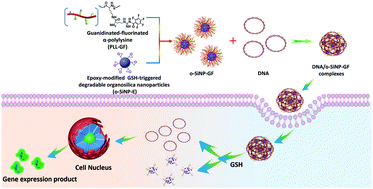Biodegradable nano-organosilica gene carrier for high-efficiency gene transfection†
Abstract
Finding and exploiting safe and high-efficiency gene carriers have always been critical tasks for gene therapy. In this work, novel GSH-triggered degradable organosilica nanoparticles grafted with guanidinated-fluorinated α-polylysine (o-SiNP-GF) are prepared to be studied as gene carriers. The organosilica matrix of o-SiNP-GF is synthesized through the hydrolysis and condensation of 1,2-bis(triethoxysilyl)ethane (BTSE) and bis[3-(triethoxysilyl)propyl]tetrasulfide (BTSPTS). The o-SiNP-GF nanoparticles have a size of about 20 nm. They possess a positive zeta potential of 42 mV in PBS (pH 7.4) and can be disintegrated in the presence of GSH. The cytotoxicity and DNA-binding ability of o-SiNP-GF, as well as in vitro gene transfection performance of DNA/o-SiNP-GF complexes, have been investigated using enhanced green fluorescent protein plasmid (pEGFP) as the DNA model. MTT assay shows that the cytotoxicity of o-SiNP-GF is very low even at a concentration up to 800 μg mL−1. The o-SiNP-GF nanoparticles can effectively bind to pEGFP through a complex coacervation method. The in vitro transfection efficiency of pEGFP/o-SiNP-GF complexes in 293T cells is up to 94.7% at the N/P ratio of 10, much higher than that of pEGFP/PEI complexes. Luciferase gene and fibroblast growth factor (FGF2) gene are also used as the DNA models to study the in vivo gene transfection performance of the o-SiNP-GF carrier by bioluminescence imaging and the evaluation of the healing rate of a mouse wound, respectively. Compared with naked DNA and DNA/PEI complexes, DNA/o-SiNP-GF complexes show much higher in vivo transfection efficiency. This work not only provides a way to prepare novel GSH-triggered degradable organosilica nanoparticles of size less than 50 nm, but also proves that the modification of guanidinated-fluorinated α-polylysine is an effective method to improve the efficiency of gene carriers.



 Please wait while we load your content...
Please wait while we load your content...